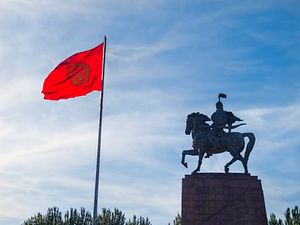Askar Akayev, Kyrgyzstan’s first president, fled the country in 2005 after a flawed parliamentary election triggered protests. He led Kyrgyzstan from 1990 until the Tulip Revolution chased him from power. On August 2, after 16 years living in exile in Russia, Akayev returned to Bishkek. Pictures on social media showed Akayev calmly deplaning, donning a kalpak and a facemask.
In early July, the head of Kyrgyzstan’s State Committee for National Security (SCNS), Kamchybek Tashiev, said that the government had added Akayev and Kyrgyzstan’s other exiled ousted president, Kurmanbek Bakiyev, to the growing list of wanted persons in connection to corruption at the Kumtor Gold Mine.
Bishkek is clearly committed to an extended battle with the Canadian mining company, Centerra Gold, which until May 17 operated Kyrgyzstan’s most lucrative asset. In early May, the Kyrgyz parliament passed a bill allowing the state to seize temporary control of the mine, which it swiftly did, boosted by conveniently timed court rulings alleging environmental damages, tax evasion, and corruption. The temporary “external management” of the mine is set to expire later this month, but there’s no indication Bishkek will give up control.
Centerra Gold has said it will pursue international arbitration against Bishkek. In an early July letter addressed to the Kyrgyz people, Centerra President and CEO Scott Perry reiterated the company’s stance that “[t]he seizure of the mine is based on false information and groundless allegations that undermine everything we have built together.”
Centerra has been involved with Kumtor since 2004, though the first agreement regarding the mine was reached in 1992. Over the years, the terms have changed as have the composition of the involved parties, particularly on the Kyrgyz government side.
As with extractive industries the world over, there have always been allegations of corruption and environmental depredations that went along with the mine’s development and operations. Across the presidencies of Akayev, Bakiyev, and Almazbek Atambayev, the contracts between the state and the company have been negotiated and renegotiated, adjustments made and compensation for environmental damage paid.
As of 2019, the mine accounted for nearly 10 percent of Kyrgyzstan’s GDP and the company was one of the state’s largest private sector employers. Despite the headaches, Kumtor remains a literal gold mine.
As of the beginning of 2021, Centerra operated the mine via a local subsidiary, the Kumtor Gold Company. The Kyrgyz state gold refining company, Kyrgyzaltyn, meanwhile, was the largest shareholder in Centerra Gold, with a 26.1 stake.
The present Kyrgyz government under President Sadyr Japarov — long a proponent of nationalizing the mine — alleges all three former presidents, among others, were involved in corrupt dealings regarding the mine.
So why, amid this mess, did Akayev return to Kyrgyzstan?
While the earliest reports were unclear on whether he voluntarily returned to the country or was made to return, it is now clear that he chose to return. After being questioned by the SCNS, Akayev met with Japarov and then told the press, per RFE/RL’s Kyrgyz Service, “I am grateful to President Sadyr Japarov for giving me the opportunity to come to Kyrgyzstan. He gave permission and I am very happy, because for the first time in 16 years I have returned to my homeland.”
Akayev said he would be in Kyrgyzstan for about a week, cooperating with the investigation into Kumtor. “I came to cooperate,” he said. “I will tell everything that I know about Kumtor. You know that I have complaints about this project: Kumtor was built under me. Therefore, I want to help the investigation and give evidence.”
Writing for Eurasianet, Ayzirek Imanaliyeva provides a concise explanation of what many think is happening behind the scenes: an extension of the Japarov government’s “catch-and-release” policy (Outlined in a June article). Put simply: Wealthy individuals — like Omurbek Babanov and Raimbek Matraimov — have been arrested and later released, usually after paying something to the state. In Babanov’s case, charges were dropped in March after he agreed to pay the state $1.2 million. Matraimov was released and paid $24 million under an “economic amnesty” scheme. Babanov was detained again in May but in late July was allowed to leave the country for medical treatment (where to and what for remain unknown.)
Imanaliyeva cited comments from Dastan Bekeshev, a Kyrgyz MP, saying that Akayev would not have returned without “assurances” and suggested an agreement had been made, possibly involving “some amount” paid.
A deposit made to ensure a safe exit from Kyrgyzstan would not be surprising. Akayev, long retired from Kyrgyzstan’s political battlefield, is making a gamble that the Japarov government is more interested in pursuing and punishing Centerra than following through with corruption charges against him. Any corruption Akayev may admit to witnessing (let alone participating in) would most certainly be weaponized to fight Centerra over the mine, rather than bring any corrupt Kyrgyz officials to justice.
































